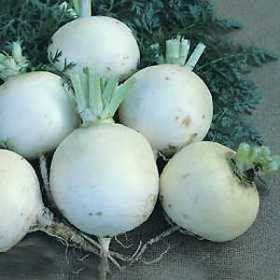How to Grow Turnips – A Guide to Growing Turnips
 Turnips
Turnips
Modern turnips are nothing like the big woody turnips of old. The small Japanese white varieties are delicious grated raw into a salad or as a wonderful side dish. Swedes are now the better choice for stews.
Although turnips don’t look like brassicas they are in fact from the brassica family , so club root may be a problem if it is in your soil. Early turnips come in a variety of shapes including round, flat and cylindrical. Main crop turnips are all round but come in white, yellow and green-top varieties.
Turnips are a quick crop to grow and can be ready to use in only five to eight weeks from sowing if you like then golf ball sized, leave them a little longer if you prefer them larger but as they grow larger they become less tender and tasty so successional sowing every two or three weeks gives a continuing supply of flavoursome young roots. Turnip tops are a delicious green vegetable.
Varieties of Turnip
Early Turnips
- Turnip Purple Top Milan is a classic flat Italian heirloom variety , which and is still popular today. It is white with purple top , fast to mature and can be grown under cloches and in frames. It is very tasty, crisp and succulent with a sweet, mild, fine-grained flesh. The greens are slightly sweet when young and are even more nutritious than the roots. They are considered one of best flavours for any greens . Recommended by the National Institute of Agricultural Botany.
- Turnip Tokyo Cross F1 is a delicious round shaped white turnip. Just right as ‘mini veg’ when golf ball size or perhaps a bit smaller. They should be grown at close spacing with rows 6 inches (15cm) apart and only 1 inch (2.5cm) between plants. Awarded the RHS Award Of Garden Merit (AGM).
- Turnip Snowball is a Japanese heirloom turnip. It is an excellent early white globe variety with solid flesh and a juicy, sweet, mild flavour. It is fast to crop and will be ready to harvest in five to eight weeks from sowing, giving a good supply from early summer to early winter. The tops are nutritious and tasty.
Maincrop Turnips
- Turnip Golden Ball is a compact , round dwarf variety with tender, yellow flesh. It is very hardy and has outstanding keeping qualities. It is an old variety and is excellent for storage and a favourite for exhibition. Recommended by the National Institute of Agricultural Botany.
Turnip Pests & Problems
As turnips are brassicas they can suffer from clubroot, and rarely from cabbage root fly. If these are a problem on your site, use a good crop rotation to reduce the likelihood of club root and cover your plants with horticultural fleece to keep the cabbage root flies off until the plants are well established. Turnips can suffer with flea beetle and powdery mildew, which both damage the leaves , especially if plants are overcrowded.
Early varieties are more demanding than main crop ones. Any check, such dryness or poor drainage or nutrition, will reduce flavour and tenderness.
Cultivating Turnips
Turnips like brassicas the need a firm, non-acidic soil. Early varieties need a good fertility as they grow so fast. Dig and lime the soil in autumn if needed and about a week before sowing apply about 50 to 75 grams of general purpose fertiliser like Growmore or fish, blood & bone .
Sow thinly where they are to remain about ½ to 1 inch (1-2cm) deep and thin out to about 4-6 inches (10-15cm) apart with 12 inches (30cm) between the rows or 6 inches (15cm) apart in both directions in raised beds. They are fast growing so it is important to thin them as soon as possible.
You can sow as early as late February under a cloche and as late as August. Give maincrop varieties that are sown in July and August a larger spacing of 10 inches (25cm) to allow for a larger root to develop. These can be harvested during November and December. Most gardeners only grow early varieties of turnip as maincrop turnip are less well flavoured and contain less in minerals and vitamins than swede.
Culinary Uses of Turnips
The small roots of early varieties of turnip can be boiled whole for around 25-30 minutes. Main crop varieties will need to be peeled thickly and cubed before boiling for about 30 minutes and then tossed in butter and parsley or mashed with butter or cream, pepper and a little lemon juice.
There’s a list of recipes using turnips as the main ingredient on this site. Maincrop turnip tops can be used as a green vegetable and the very young leaves of any turnip can be used raw in a salad. Young, small turnips can be sliced or grated and eaten raw in salads although some people may find them indigestible. The leaves of autumn sown turnips can be used as tasty spring greens and are even more nutritious than spinach. Turnips can be frozen after cubing and blanching.




